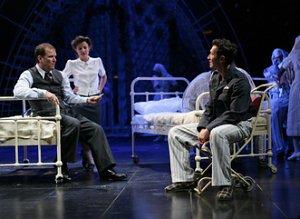A Matter of Life and Death
It is hard to know what to make of A Matter of Life and Death. Based on the film by Michael Powell and Emeric Pressburger, it retells the story of an RAF pilot without a parachute who jumps to certain death from his blazing Lancaster bomber in May 1945; addressing his last words to June his radio operator, a girl he has never met.
Following an angelic error, caused by a classic English pea-souper, Peter Carter miraculously survives and finds June in the flesh. But things are not so simple. To stay alive, Peter is forced to take himself, and the heavenly authorities, to the Universal Court of Appeal. So begins a desperate campaign to prove to a celestial court that he deserves to live when so many others have died; while on earth, his doctor tries to work out what sort of brain injury might make him see visions and assail him with a strong smell of burnt toast.
The case of Peter Carter vs. the Universe although entertaining, is perhaps a little too self-consciously clever. The idea of Shakespeare in prosecution for example, obviously the greatest fear of any poet, is ingenious but taken too far and by the time we've met him and found him to be a nasty piece of work, it is hard to continue caring about the outcome of the case.
Designer Bill Mitchell makes thrilling circus-style use of the wide-open Olivier stage and the production is a flashy piece of physical theatre; with fires burning on stage, actors climbing ropes, beds swinging from the ceiling and a line of nurses frantically bicycling upside down while in bed.
Mitchell creates a set capable of evoking heaven and earth, burning planes and hospital wards. The use of lighting is particularly effective in creating an other-worldly atmosphere and the projection of various images onto the background is visually striking and entertaining, especially when a camera obscura effect is turned into a lavish panorama of life on the Southbank, complete with a nurse cycling in front of the London Eye. The spectacle before us is continuously awe-inspiring, there are no pauses, no interval, instead constant movement. However, this is often at the expense of the narrative thread, sense is subordinated to spectacle and although incessantly entertained the audience is left wondering what the unifying theme of the plot was.
With 22 actors and five musicians, this is a large ensemble even for the National. The male cast is extremely strong: Tristan Sturrock as Peter has the presence of a romantic comedy lead, Douglas Hodge as the life-affirming neurosurgeon displays great vocal talent but it is Gisli Orn Gardarsson as Magnus the Magnificent, a failed Norwegian magician, who steals the show. As a clown in tights with a slight look of Freddie Mercury, he offers touches of pantomime, making great use of his acrobatic frame to brilliant comic effect. Unfortunately, June is not as convincing but this was not so much Lyndsey Marshal's failure as that of the scriptwriters. The only strong female performance came from Dorothy Atkinson's somber black figure, a mysterious presence throughout, emerging as a victim of the bombing and making a case against war and the killing of innocents.
The play is tilted into musical theatre's direction, with a few song and dance numbers including a table-tennis game between June and the surgeon, wittily choreographed with the aid of ping-pong balls on poles. Needless to say, though, that this is extremely bizarre and adds to the incoherence of the whole. However, Stu Barker's first-rate score ranging from jazz to rap to a bit of the blues to tango and played by a five-strong band on stage throughout, forming a regular accompaniment, is an integral part of the entertainment value of the production.
The programme features an idealistic passage from the United Nations charter, published in 1945 as the film was being made, about freedom and "the economic and social advancement of all peoples." In keeping with this, the play finishes with a pessimistic assault on the random brutality of war, symbolized by voices echoing the names of the many wars in our history and a final projected background of photos of those killed in war, but ultimately the message is lost in the cacophony and chaos of the storyline. What makes the production special, namely the song and dance routines and the set also detract from the message that director Emma Rice was trying to convey. There is so much going on that it is hard to keep any of it even in short term memory. A little like the penny that is tossed to see whether Peter will live or die, this play is a toss-up and although it received a good reception from the audience it is a divisive case: you'll either love it or you'll hate it but you probably won't quite understand it!
(Chloe Preece
What the popular press had to say.....
NICHOLAS DE JONGH for THE EVENING STANDARD says, "Glossed-up, flamboyant piece of physical theatre." MICHAEL BILLINGTON for THE GUARDIAN says, "A fascinating reappraisal of the original work, flawed only by a lack of narrative dynamic." CHARLES SPENCER for THE DAILY TELEGRAPH says, "Somehow the magic of the movie has gone almost entirely awol." JOHN THAXTER for THE STAGE says, "An immensely enjoyable evening of physical, musical and dramatic theatre." BENEDICT NIGHTINGALE for THE TIMES says, "Rice and her co-adaptor, Tom Morris, have made big changes to the film, not always for the better."
External links to full reviews from popular press
The Guardian
Daily Telegraph
The Times
Production photos by Steve Tanner
Originally published on
